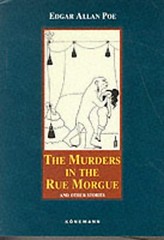
The Murders in the Rue Morgue and Other Stories / Edgar Allan Poe.
Köln : Könemann, 1995
310 p.
The portrait painted by an artist robs his sitter of her life. A jester dwarf takes terrible revengo on the king and his court. The Red Death stalks the chambers of Prince Prospero. The razor-edged pendulum swings lower towards a prisoner of the Inquisition. And Montresor takes Fortunato to a dank Roman cellarage, to taste an Amontillado...
Ten of Edgar Allan Poe's great tales of horror, jeopardy and death, and the four classic tales with which he created a new genre, the detective story: 'The Gold-Bug', 'The Murders in the Rue Morgue', 'The Mystery of Marie Rogêt' and 'The Purloined Letter'.
Ok, so everybody knows who Edgar Allan Poe is, everybody thinks of him as that quintessential creepy author, and everybody can recite the opening lines to that poem from the Simpsons Halloween special. So believe me when I say that it is with great trepidation that I make the following statement:
Wow, guys, I really don't care at all for this dude's short stories.
I'll start at the beginning. The desire to read his short stories was first planted when I was in college taking a course called Opera on the U.S. Stage Since 1950. We watched this crappy old VHS copy of a very cool opera called "Ligeia", which was based on Poe's story of the same name. I loved the opera primarily for the story, which I found to be one of the smartest, most creepy and haunting stories I'd ever known.
So when I came across this collection in a used bookstore with "Ligeia" in it, it was a no-brainer. I finally read it this month, and that was definitely my favorite story of the bunch for all the same reasons I liked the opera.
Of the other stories, I also enjoyed "The Pit and the Pendulum" and "Hop-Frog" quite a bit. And to a lesser extent, "The Cask of Amontillado". The other ones just didn't do it for me. I divided them into two camps: "The Creepy" and "Those Mystery Ones".
The Creepy bunch bothered me because, yes, I understand that Poe was touching on some deep psychological ideas, but that's really all he did... touch on them. These are things that have since been taken and expanded upon such that the original ideas presented so tersely here do not really hold up. And people talk about recurring themes in these stories, one of which is the death and rebirth of a beautiful woman. The stories "Morella", "Ligeia", "Berenice", and "Eleonora" all fit this, but it's not just a recurring theme. It's a recurring plot. I felt like he was telling the same story over and over with minor variation. "Really? She was pretty? How pretty? Wow, that's pretty. Oh, she died? Crap. Don't worry, she'll be back. See, here come her teeth now!"
Those Mystery Ones I had a lot less tolerance for, perhaps because they were at the end of the collection. Spoiler alert, by the way, I'm about to give away the ending to one. Basically Poe would set up a murder mystery and then solve it. I understand that these are sort of proto-mystery stories, but they were so dryly presented. First the scene, then the facts quoted from false newspaper articles and then the solution. Here's the spoiler: The murders in the Rue Morgue were committed by an angry monkey. REALLY, Eddy? A monkey? The best part of these mysteries is how they can be solved in mundane ways. It's like reading a 400-page locked-room mystery novel to have the last page say "MAGIC IS REAL IT WAS SNAPE!"
But I get it. I see why these stories have lasted so long and the impact they've had on gothic and detective fiction. Really. I just don't see them as something I'd ever pick up again with the exception of the ones I mentioned liking.



No comments:
Post a Comment